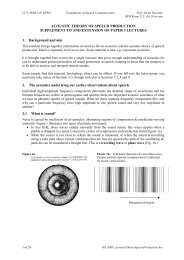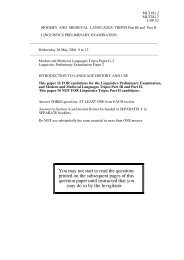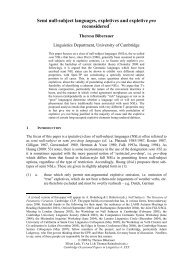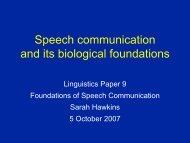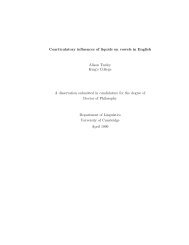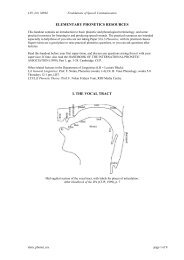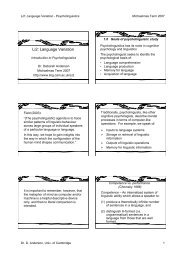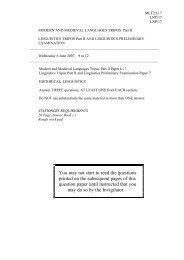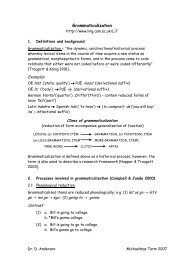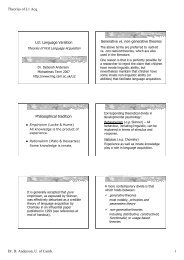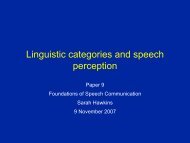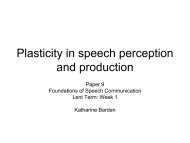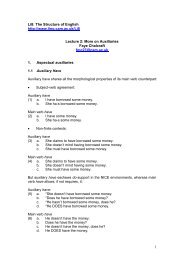ACOUSTIC THEORY OF SPEECH PRODUCTION ... - Ling.cam.ac.uk
ACOUSTIC THEORY OF SPEECH PRODUCTION ... - Ling.cam.ac.uk
ACOUSTIC THEORY OF SPEECH PRODUCTION ... - Ling.cam.ac.uk
You also want an ePaper? Increase the reach of your titles
YUMPU automatically turns print PDFs into web optimized ePapers that Google loves.
Paper 9 etc: M4_AcThSpProd 11 of 20<br />
A constriction effectively divides the vocal tr<strong>ac</strong>t into two tubes, e<strong>ac</strong>h with its own resonance<br />
frequencies.<br />
• the location of the major constriction in the vocal tr<strong>ac</strong>t determines the length of the front and<br />
b<strong>ac</strong>k cavities;<br />
• the cross-sectional area of one tube relative to the adj<strong>ac</strong>ent tube determines whether its ends are<br />
modelled as closed or open. This principle is illustrated in Figure 12. It’s not crucial that you<br />
understand it, but if you do, then you can work out formant frequencies for yourself using a<br />
tube model of the VT.<br />
Figure 12: To determine boundary conditions: (c = closed; o = open)<br />
open<br />
closed closed open c c o o<br />
The type of boundary condition is what you would mainly see if you were inside one tube, looking out<br />
from one end (or, towards its end): mainly “closed” wall, or mainly “open” air.<br />
7.1.1 Examples for vowels<br />
Two tubes, e<strong>ac</strong>h of uniform cross-sectional area.<br />
Figure 13: Model for [A]<br />
g<br />
Lb<br />
c<br />
Lf<br />
l<br />
g<br />
l<br />
c<br />
glottis<br />
lips<br />
point (or region)<br />
of maximum<br />
constriction<br />
Lb = length of b<strong>ac</strong>k cavity (glottis to point of maximum constriction)<br />
Lf = length of front cavity (point of maximum constriction to lips)<br />
Boundary conditions: both b<strong>ac</strong>k and front cavities are modelled as closed-open.<br />
So the quarter-wavelength model (as for schwa) is used for e<strong>ac</strong>h tube separately. Roughly:<br />
Lb = 7cm<br />
c/4l 34000/28 = 1215 Hz<br />
3(c/4l) 3 (1215) = 3645 Hz<br />
Lf = 10cm<br />
34000/40 = 850 Hz<br />
3 (850) = 2550 Hz<br />
First 3 formant frequencies measured at lips for this vowel should be:<br />
F1 = 850 Hz (lowest front-cavity resonance)<br />
F2 = 1215 Hz (lowest b<strong>ac</strong>k-cavity resonance)<br />
F3 = 2550 Hz (second front-cavity resonance)<br />
These values are slightly high for an adult male, because the model is too simple to allow precise<br />
prediction of formant values. But the general pattern of formants is right: for [A], F1 is high and close<br />
to F2.<br />
M4_0708_AcousticTheorySpeechProduction_07-8.doc



